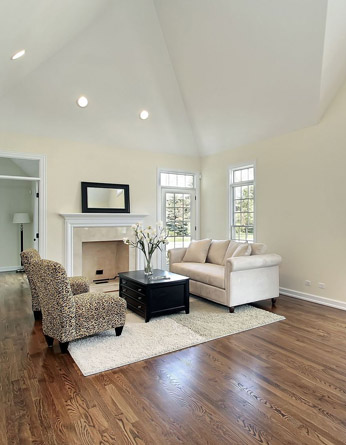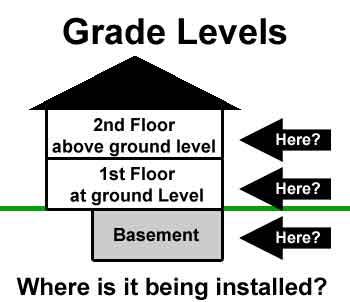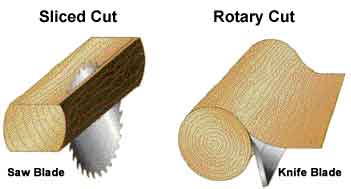Hardwood Choices
Your home reflects your style, so should your hardwood flooring.
A home mirrors those who live there, it’s a truth of life. What’s under your roof, over your mantel and throughout your rooms, reflects who you are, what you love, where you’ve been. Your style.
And to help you find the hardwood that suits your style, we’ve created this section called Hardwood Choices.
The number of hardwood choices, patterns, colors, textures and price points can intimidate even the most experienced shopper.
Knowing the basic styles can provide you with a firm foundation upon which to begin your hardwood-shopping journey.
Here you’ll learn all about the wide array of hardwood types on the market today. You’ll discover the beautiful yet practical styles, the elegant and easy-care types – the entire spectrum of hardwood choices available for your every room.
Choosing your ideal hardwood style is all about knowing the right combination of aesthetics, performance and budget that meets the needs of your lifestyle.
Considering the vast amount of design options available today with hardwood floors, you can create a look “all your own” that will have lasting beauty and durability.
For example, inserting decorative medallions, running the boards on the diagonal, or creating a border are just some of the design styles one can consider.
But hold on. Before you get to the design, you need to select the type of hardwood that’s right for you and your home.
Today you can choose between a pre-finished hardwood floor and one that is unfinished. Pre-finished hardwood comes ready for installation in your home. The hardwood boards have already been sanded, stained and finished at the manufacturing plant. In many cases this can provide a harder, better- protected surface.
Pre-finished floors offer a wider variety of wood species and save hours of labor and cleanup. But unfinished wood floors allow you to have a custom job – you choose the wood species and it’s sanded and the stain is applied on site. With unfinished you also have the chance to level the surface of the entire floor after it has been installed.
You get an extended factory finish warranty with pre-finished floors, but not with most job-site finishes
To learn more about this, we suggest you go to the hardwood sections entitled Hardwood Construction, Before Buying Hardwood and Before Your Hardwood Arrives. For more on styles, please read on.
Remember, it’s all about location.
To begin with, you need to look at where you plan on installing your new wood floor.
There are limitations on where some wood floors can be installed. This is especially true for the 3/4" solid wood floors.
Solid hardwood floors are more susceptible to moisture and are generally not recommended for basements, or installing directly onto a concrete slab.
Now understand grain and cut.
Hardwood styles are the result of the wood species available. Some of the more common species are red oak, white oak, maple, cherry, white ash, hickory or pecan.
Each species has its own unique graining and texture. The graining on the boards is determined by the way it has been cut.
There are two cutting processes. “Sliced Cut” shows a more uniform pattern, whereas “Rotary Cut” displays a larger and bolder graining pattern.
Next, choose your color wisely.
Within each species of hardwood you will have a choice of color and finishes. Here’s where it pays to shop carefully.
When selecting a color, choose one that either coordinates or contrasts with your cabinetry and furniture.
Also keep in mind that darker woods tend to be more formal while natural colors are more casual.
Select a finish that suits your style.
You should be aware that there are different types of finishes depending on whether your hardwood floor is pre-finished or job site finished.
In general, lower gloss levels are better suited for active rooms. This is because lower gloss or matte finishes help minimize the appearance of dirt and scratches.
Consider the elegant look of the high gloss finish for a more formal décor.
Yesterday’s upkeep is a thing of the past.
The days of having to wax and scrub your hardwood floors are pretty much gone forever. Manufacturers of pre-finished wood floors have developed sophisticated techniques to quickly apply hard, durable, urethane-based finishes right at the factory.
By using ultra violet lights the pre-finished wood planks can have several coats of urethane applied within a matter of a few minutes. This is helping make hardwood floors both more affordable, and much easier to maintain.
Recently, the hardwood flooring manufacturers have begun to add small chips of Aluminum Oxide directly to the floor's finish which dramatically increases the life of the urethane finish.
Floor protection wears many coats.
Most factory finished hardwood floors have several coats of finish applied to the wood's surface.
For example, many wood floor companies are applying 6-10 coats of a ultra-violet (UV) cured urethane. This type of finish would be extremely difficult for someone to duplicate on a job site finish.
In addition, factory finishes tend to be more consistent and durable.
This does not mean you should wash your floor with a mop (as a matter of fact, excessive water is not a friend of hardwood), but it does mean these floors won't watermark like the old waxed hardwood floors. The UV cured urethane wood finishes do make these floors easier to maintain than the old waxed hardwood floors.
Pre-finished hardwood finishing offers you these choices:
- UV-cured – Factory finishes that are cured with Ultra Violet lights versus heat.
- Polyurethane – A clear, tough and durable finish that is applied as a wear layer.
- Acrylic-urethane – A slightly different chemical make up than Polyurethane with the same benefits.
- Ceramic – Advanced technology that allows the use of space-age ceramics to increase the abrasion resistance of the wear layer.
- Aluminum Oxide – Added to the urethane finish for increased abrasion resistance of the wear layer, which is becoming extremely popular on the better grade wood floors.
- Acrylic Impregnated – Acrylic monomers are injected into the cell structure of the wood to give increased hardness and then finished with a wear layer over the wood.
Job-site hardwood flooring finishing methods provide these options.
If you have an acceptable subfloor surface, and you want a custom stained hardwood floor or a wood floor to match existing trim, than a job-site finish is your answer.
Job-site finish means you start with a bare (unfinished) hardwood floor and than the floor is sanded, stained, and finished in your home.
The other advantage of a job-site finish is, if you are concerned with uneven heights between planks, the sanding process will smooth out the floor. Be warned, though, this can be quite a mess and the process does take several days.
Job-site hardwood floor finishing methods include:
- Water Based Urethane – Water is used as part of the chemical make up of the polyurethane finish.
- Solvent Based Urethane – Oil is used as part of the chemical make up of the polyurethane finish.
- Moisture Cured Urethane – A similar chemical make up as solvent based urethanes, but this finish needs the humidity (moisture) in the air to cure.
Board widths and their influence.
When shopping for a hardwood floor you will see boards in various sizes. The narrower board widths are referred to as “strips” and the wider units as “planks.”
You should be aware that board width can visually impact a room.
Narrow width boards will expand a room, while wider boards work well in a larger room or area.



Edge knowledge you should be aware of.
Different hardwood floors have different edges. Hardwood floors come in either a beveled edge, or a square edge. Each edge creates its own specific look and feel to final installation.
Here’s a summary of today’s hardwood edge types:
Square Edge:
The edges of all boards meet squarely creating a uniform, smooth surface that blends the floor together from board to board. The overall look of this floor gives a contemporary flair and formal feeling to the room.
Eased Edge:
Each board is just slightly beveled. Some manufacturers add an eased edge to both the length of the planks as well as the end joints. Eased edges are used to help hide minor irregularities, such as uneven plank heights. Eased edge is also called micro-beveled edge.
Beveled Edge:
These products have a very distinctive groove in them. Beveled edge planks lend themselves to an informal and country decor. With the urethane finishes applied at the factory today, the beveled edges are sealed completely, making dirt and grit easy to be swept or vacuumed out of the grooves.
Species Guide
Determining your floor’s hardness is easy.
Below are listed the relative hardness for numerous wood species used in flooring.
These ratings were done using the Janka Hardness Test, which measure the force needed to embed a .444 inch steel ball to half its diameter in a piece of wood.
The higher the number the harder the wood. Although this is one of the best methods to measure the ability of wood species to withstand indentations, it should be used as a general guide when comparing various species of wood flooring.
The construction and finish also play an important role in the durability and ease of maintenance of any wood floor.
| Wood Species | Hardness Rating |
|---|---|
| Douglas Fir | 660 |
| Southern Yellow Pine (short leaf) | 690 |
| Southern Yellow Pine (Long leaf) | 870 |
| Black Cherry | 950 |
| Teak | 1000 |
| Black Walnut | 1010 |
| Heart Pine | 1225 |
| Yellow Birch | 1260 |
| Red Oak (Northern) | 1290 |
| American Beech | 1300 |
| Ash | 1320 |
| White Oak | 1360 |
| Australian Cypress | 1375 |
| Hard Maple | 1450 |
| Wenge | 1620 |
| African Pedauk | 1725 |
| Hickory | 1820 |
| Pecan | 1820 |
| Purpleheart | 1860 |
| Jarrah | 1910 |
| Merbau | 1925 |
| Santos Mahogany | 2200 |
| Mesquite | 2345 |
| Brazilian Cherry | 2350 |
Those are the basics regarding hardwood flooring types and styles.
We hope this helps sharpen your focus on a hardwood style to match the pattern of life in your home.
Red Oak
Red Oak is the most abundant growing species in the United States. The sapwood of Red Oak is white to light brown while the heartwood has a pinkish reddish brown tone. It comes in four different grades:
Quartersawn
highest quality with almost no knotholes or color deviation.
Smooth Finish suggested.
Select
Second highest quality with few knotholes and very slight color deviations. Smooth finish suggested.
#1 Common
Third highest quality with more pronounced knotholes and color
deviations. Suggest hand scraped or smooth.
#2 Common
Lowest quality with many knotholes and color deviations. Suggest hand scrape only.
White Oak
White Oak is similar to Red Oak but is slightly more dense and has longer rays. The sapwood is light colored and the heartwood is light to dark brown. White Oak comes in the same four grades as Red Oak:
Quartersawn
highest quality with almost no knotholes or color deviation.
Smooth Finish suggested.
Select
Second highest quality with few knotholes and very slight color deviations. Smooth finish suggested.
#1 Common
Third highest quality with more pronounced knotholes and color
deviations. Suggest hand scraped or smooth.
#2 Common
Lowest quality with many knotholes and color deviations. Suggest hand scrape only.
Cherry
American Cherry grows primarily in the Midwestern and Eastern United States and is very hard and dense. The sapwood varies from a rich red to reddish brown and will darken with age. The sapwood tends to be a creamy white.
Hickory/Pecan
Hickory is the hardest, heaviest, and strongest American wood. The sapwood of hickory is white and the heartwood is pale to reddish brown. It can be finished smooth or hand scraped.
Maple
Growing in the Pacific Northwest, maple tends to be light but a very dense wood. Generally there is no marked difference between the sapwood and heartwood. Because of its density, maple is not recommended for high humidity areas. Smooth Finish suggested.
Pine
Tends to be a soft wood that absorbs moisture very well and is recommended for high humidity areas. The sapwood in pine is usually light yellowish-white while the heartwood tends to be yellowish-orange. Can be finished smooth or hand scraped.
Reclaimed Pine
Same characteristics as Pine, however it is recycled from old buildings (usually barns).
Walnut
Walnut grows primarily in the Eastern United states. The sapwood tends to be white while the heartwood ranges from a deep chocolate to purplish black. Walnut is great for borders and is finished smooth.
Mesquite
Mesquite grows primarily in the Southern United states and is known for being a very hard and durable wood. The sapwood tends to be pale while the heartwood is reddish brown. Mesquite usually contains lots of knotholes and a smooth finish is recommended.



